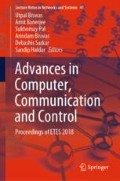Abstract
The foremost idea dominating the ongoing trends in VLSI circuits is to offer large-scale integration coupled with extensive power reduction solutions. This significant increase in the gate switching energy has resulted in higher power decadence and a costly replacement of heat sinks. At such places to limit the dissolution of power, elective arrangements at various levels of contemplation are suggested. This power dissipation is significantly minimized by the adiabatic logic structure at the cost of circuit complexity to accomplish minimal power dissipation. A brief approach of the aforementioned is included in this paper introducing the adiabatic logic family SAL. The implementation of the 4-bit CLA and 2 × 1 multiplexer combinational circuit and the sequential circuit of D flip-flop using NAND gates validates the credibility of the logic. A graph has been plotted to show the effect of temperature on subthreshold adiabatic logic-based 4-bit CLA. It aims at comparing the effectiveness of adiabatic logic with respect to power dissipation and delay. The setup and hold time graphs for sequential circuits have been plotted, respectively. The simulation results obtained from the virtuoso environment of cadence tool suggest commendable threefold power reduction in the SAL topology as compared to the conventional adiabatic topology.
Access this chapter
Tax calculation will be finalised at checkout
Purchases are for personal use only
References
Maurya, A.K., Kumar, G.: Adiabatic logic: energy efficient technique for VLSI applications. In: International Conference on Computer and Communication Technology (ICCCT), pp. 234–238. IEEE (2011)
Kalyani, P., Kumar, P.S., Chandrashekhar, P.: Energy efficient logic gates using subthreshold adiabatic logic. In: IEEE International Conference on Electronics and Communication Systems (2015)
Chanda, M., Jain, S., Sarkar, C.K.: Implementation of subthreshold adiabatic logic for ultralow-power application. IEEE 23(12) (2015)
Athas, W.C., Svensson, L.J.: Low power digital system based on adiabatic-switching principles. IEEE Trans. VLSI Syst. 2(4), 398–407 (1994)
Mishra, A., Singh, N.: Low power design using positive feedback adiabatic logic (PFAL). Int. J. Sci. Res. 3(6) (2014)
Kanungo, J., Dasgupta, S.: Performance analysis of a complete adiabatic logic system driven by the proposed power clock generator. IOPscience 35(9) (2014)
Soeleman, H., Roy, K., Paul, B.C.: Robust subthreshold logic for ultra-low power operation. IEEE Trans. Very Large Scale Integr. (VLSI) Syst. 9(1), 90–99 (2001)
Wang, A., Calhoun, B.H., Chandrakasan, A.P.: Sub-Threshold Design for Ultra Low-Power Systems. Springer, New York, NY, USA (2006)
Calhoun, B.H., Chandrakasan, A.P.: Static noise margin variation for sub-threshold SRAM in 65-nm CMOS. IEEE J. Solid-State Circuits 41(7), 1673–1679 (2006)
Narendra, S.G., Chandrakasan, A.: Leakage in Nanometer CMOS Technologies. Springer, New York, NY, USA (2006)
Ojha, P., Rana, C.: Design of low power sequential circuit by using adiabatic techniques. Int. J. Intell. Syst. Appl. 08, 45–50 (2015). https://doi.org/10.5815/ijisa.2015.08.06
Bhati, P., Rizvi, N.Z.: Adiabatic logic: an alternative approach to low power application circuits. In: International Conference on Electrical, Electronics, and Optimization Techniques (ICEEOT) (2016)
Kumar, C.P., Tripathy, S.K., Tripathi, R.: High performance sequential circuits with adiabatic complementary pass-transistor logic (ACPL). In: TENCON, pp. 1–4. IEEE (2009)
Author information
Authors and Affiliations
Corresponding author
Editor information
Editors and Affiliations
Rights and permissions
Copyright information
© 2019 Springer Nature Singapore Pte Ltd.
About this paper
Cite this paper
Yadav, R., Bakshi, A. (2019). Low-Power Subthreshold Adiabatic Logic for Combinational and Sequential Circuits. In: Biswas, U., Banerjee, A., Pal, S., Biswas, A., Sarkar, D., Haldar, S. (eds) Advances in Computer, Communication and Control. Lecture Notes in Networks and Systems, vol 41. Springer, Singapore. https://doi.org/10.1007/978-981-13-3122-0_16
Download citation
DOI: https://doi.org/10.1007/978-981-13-3122-0_16
Published:
Publisher Name: Springer, Singapore
Print ISBN: 978-981-13-3121-3
Online ISBN: 978-981-13-3122-0
eBook Packages: EngineeringEngineering (R0)

